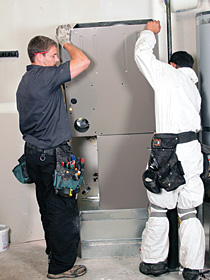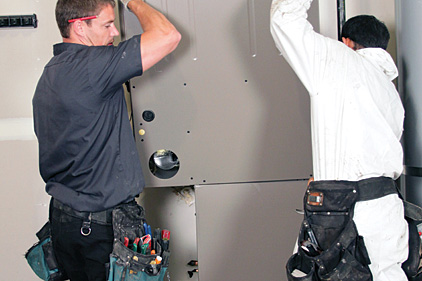
|
| The Department of Energy decided to not enforce the regional efficiency standards ruling pending a settlement. In the Northern region, gas furnaces would’ve had to meet a minimum 90 percent AFUE. |
Contractors are relieved after the U.S. Department of Energy (DOE) announced it will not enforce a rule requiring nonweatherized gas furnaces in the Northern region adhere to a minimum 90 percent AFUE standard beginning May 1.
The announcement, publicized April 5, announced that the DOE will refrain from enforcement of the rule until the court rules on a pending settlement agreement in the DOE v. American Public Gas Association (APGA) lawsuit. While contractors are admittedly embracing this temporary sense of certainty, they’re still left with more questions than answers.
>>Click here to view the Regional Standards Timeline<<
Lapse in Leadership
Butch Welsch, president, Welsch Heating & Cooling, St. Louis, said he’s concerned about the whole situation, proclaiming it’s an example of inept government.
“I’m essentially being told by the government to break its own law,” Welsch said. “What worries me is what happens if a new guy comes in to run the DOE and tells us we’ve been breaking the law for a period of time? To me, when you step back and look at it, it’s a joke, it’s ridiculous.
“If the DOE made a mistake in making this law, then OK, admit it and then change the law or get rid of it. But don’t sit around and talk about it for six months.”
Adam Gloss, vice president, Bel Red Energy Solutions, Mukilteo, Wash., said he would’ve liked to have seen the DOE take action sooner, but the nonenforcement ruling was the prudent thing for them to do.
“Immediately, it’s a sigh of relief,” Gloss said. “There were a lot of questions about what would be available, what would be legal, what would be illegal, and how it would be enforced. There was a lot of rulemaking that was supposed to be done around this that hasn’t even been touched. The distributors that we work, we heard that they weren’t even shipping noncompliant equipment into this market. It was creating a lot of worry among our customers and among contractors. It’s a sigh of relief and a chance to take a breather. Hopefully it will be finalized soon.”
Questioning the Consequences
Prior to the DOE statement, as contractors attempted to gear up for the May 1 deadline, many were left wondering how the rule would be enforced.
“The enforcement of this is very problematic,” Gloss said. “How do you, as a contractor working in both the Northern and Southern regions, make sure equipment isn’t coming across the DOE’s line? How do you deal with Internet sales? Some of the black market is going to exist. There’s some real problems with the way the rule was written in the first place and how it’s going to be enforced, and not knowing how it’s going to be enforced is still a problem.”
Ed Bartram, president, Diversified Heating & Cooling, Farmington Hills, Mich., said he’s spoken with several local inspectors who weren’t sure what the situation was, either.
“Who’s going to regulate? There has been no guidance and there’s nobody there,” Bartram said. “Why do you make a law where you’re not going to have some way to enforce it?”
The practicality of the law is what is most upsetting for many, though, because not every situation allows for a 90 percent AFUE standard furnace.
“If the regional standards said something like, ‘this is what we’ve preferred you to sell, but if you have reason it won’t fit, sell something lower,’ that would be fine,” Bartram said. “There should be some leeway for the contractor, city, or the inspectors. There are times there just isn’t a good way to do it. The idea is to make the homes more energy efficient and bring the operating costs down. I think it should be left up to the customer for what they want to do, to be honest.”
Bringing out the Worst
There’s much concern about what a potential ruling may do in terms of creating a black market, especially in areas where contractors serve customers across state lines that split the 90 percent and 80 percent mandates.
Gloss believes this situation could lead law-abiding contractors into making poor decisions and stepping into what he called a breach.
Even more so, Welsch questioned enforcement so far as to ask what’s stopping a contractor from getting a big truck, driving a few hours south, and loading it up with furnaces that aren’t compliant in his or her state.
“There is nothing to keep an unscrupulous contractor from taking a nice-sized truck to Little Rock or Memphis and picking up a bunch of 80 percent furnaces and bringing them back and putting them in here in St. Louis,” Welsch said.
“One of my biggest concerns is that this could bring out the worst in guys. Going and picking up a load of 80 percent furnaces and installing them in places like condominiums, where it may be difficult to install a 90 percent furnace,” said Welsch. “These contractors would likely refuse to take out permits, and that would be the worst thing for us. We’re trying to clean this industry up, not encourage people to circumvent things. It was a very ill-advised standard when it was written. Somebody didn’t stop and think about all the ramifications. The regional idea might be a good idea, but there’s got to be a better way to make it happen.”
With the dividing line being so slim in some cases, it brings up many ethical questions, ones Bartram is glad he doesn’t have to face.
“I’m glad I don’t live in Virginia or something like that where it depends on what side of the street you live on,” he said. “There should be grey areas. We can all see if someone is building a new home, it should be 90 percent or higher because you have the chance to rearrange what’s being built. But when it’s already built, logistically, it ought to be the customer’s choice.”
Stocking Woes
With the amount of uncertainty regarding the ruling, and whether or not it would be enforced, the industry was left in a bind with what stock they had left.
“From a real standpoint out there, if you talk to manufacturers, they’ll tell you that if, all of a sudden this were to happen on May 1, this part of the country would be in a severe dilemma,” Welsch said. “The manufacturers and wholesalers, they aren’t prepared for us to switch. In our new construction work, we send out probably 2,500 furnaces in a year, or about 50 a week. I can tell you our suppliers are not geared up for us to call them and tell them we need those 50 furnaces to be 90 percent and not 80 percent. They don’t have that kind of inventory.”
Gloss, though, said his company, Bel Red, prepared for the May 1 date like it was going to happen. Even though it will not be enforced at this time, he said they are ready the moment it does flip.
“We worked with our distributor and had a plan in place to move all that stock out prior to the May 1 date,” he said. “We put that plan on hold once the announcement from the DOE came out. Right now everything’s in a state of limbo, so it is business as usual until we hear that it’s not. If this is resolved, or if the DOE has a sudden change of heart, we can reinstate that plan pretty quickly. So we know we won’t get stranded with equipment. It’s a giant rollercoaster and it’d be nice to have a straight track for a while.”
Hopeful Finish
Welsch said somebody needs to step in and say that this kind of situation isn’t acceptable. Still, he’s happy to have, at least for now, some clarity regarding the situation, which he openly refers to as a joke.
“I think they need to clean (the law) up,” he said. “But because of all those situations where 80 percent furnaces make more sense, we’re going to continue to install 80 percent furnaces. I’m just hoping somebody isn’t going to come along and say we’re putting something in that’s not in accordance with the law.”
Gloss looked into his crystal ball and predicted a happy ending for contractors.
“I would hope this portion of the rule is fully rescinded and the settlement is accepted,” he said. “I’m hopeful that will happen. I’m hopeful DOE will go back to rulemaking on this and involve parties that need to be involved and come up with something that makes a little more sense.
“I think encouraging energy efficiency is very important. We do it in our business regardless of whatever rule there is. You have to recognize, though, that there’s times when mandating minimum-efficiency performance isn’t practical or doesn’t make sense. If we can get involved in the rulemaking at the right stage this time, we can come out with something that works for everybody that has a benefit to society and everybody wins.”
Publication date: 5/6/2013
Want more HVAC industry news and information? Join The NEWS on Facebook, Twitter, and LinkedIn today!



Report Abusive Comment